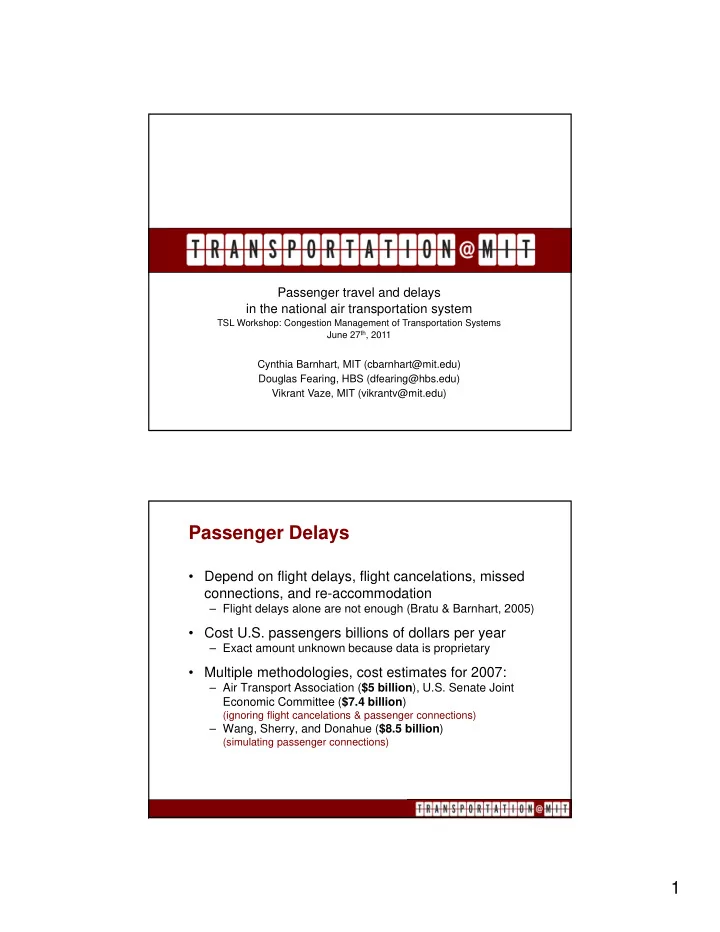

Passenger travel and delays in the national air transportation system TSL Workshop: Congestion Management of Transportation Systems June 27 th , 2011 Cynthia Barnhart, MIT (cbarnhart@mit.edu) Douglas Fearing, HBS (dfearing@hbs.edu) Vikrant Vaze, MIT (vikrantv@mit.edu) Passenger Delays • Depend on flight delays, flight cancelations, missed connections, and re-accommodation – Flight delays alone are not enough (Bratu & Barnhart, 2005) • Cost U.S. passengers billions of dollars per year – Exact amount unknown because data is proprietary • Multiple methodologies, cost estimates for 2007: – Air Transport Association ( $5 billion ), U.S. Senate Joint Economic Committee ( $7.4 billion ) (ignoring flight cancelations & passenger connections) – Wang, Sherry, and Donahue ( $8.5 billion ) (simulating passenger connections) 2 1
Outline of Slides • Passenger travel and delay estimation • Annualized cost of passenger delays • Selected findings • Missed connection analysis • Delays due to disruptions • Next steps 3 Data Sources • Planned flight schedules – Flight on-time performance data • Flight seating capacities – Airline inventories, aircraft codes, monthly seat counts • Aggregate passenger demand data – Monthly segment demands, quarterly 10% coupon samples (one-way itineraries) • Proprietary booking data – One quarter for a major U.S. carrier 4 2
Passenger Travel Estimation • Developed multinomial logit model of itinerary shares – Regression function includes time-of-day, day-of-week, connection time, cancelations, and seats – Trained on one quarter of booking data from a large carrier • Generate potential non-stop and one-stop itineraries from flight schedule data • Randomly allocate passengers to itineraries based on estimated logit proportions – Using aggregated passenger demand data to determine total number of passengers and one-stop route proportions 5 Passenger Delay Calculation • Extension of Passenger Delay Calculator developed by Bratu & Barnhart (2005) • Disrupted passengers are determined by analyzing historical flight schedule data • Passengers are re-accommodated on alternative itineraries in the order they are disrupted – Attempt re-accommodation on ticketed carrier and partner carriers first, and then consider all carriers • Maximum delay of 8 hours for daytime disruptions (5:00am - 5:00pm) / 16 hours for evening disruptions 6 3
Annualized Costs of Delays • Estimated 245 million hours of U.S. domestic passenger delays in 2007 • Total cost of $9.2 billion – Assuming $37.60 per hour value of passenger time (same value as used in other reports) • Out of all passenger delay, – (only) 52% due to flight delays – 30% due to canceled flights – 18% due to missed connections • Average passenger delay of 30.2 minutes – Compared to average flight delay of 15.3 minutes 7 Finding #1 • Ratio of passenger delay to flight delay is highest for regional carriers and lowest for low-cost carriers – Primary drivers are cancelation rates and percentage of connecting passengers Regional Legacy Low-cost Overall Pax delay to flight delay 2.6 2.0 1.6 2.0 Cancelation rate 3.4% 2.2% 1.2% 2.4% Connecting pax 39.6% 31.0% 17.0% 27.2% 8 4
Finding #2 • EWR, ORD, LGA, IAD, JFK, and PHL are the worst connection airports in terms of passenger delays – Also the only airports where at least 10% of connecting passengers are disrupted 6 worst All others Connecting pax delay 78.5 min. 45.6 min. Due to flight delays 29.4% 34.9% Connecting pax disrupted 12.2% 6.9% 9 Finding #3 • Passenger delays are 87% higher on average in the evening than in the morning – Primary drivers are differences in average flight delays, percentage of passengers disrupted, and ease of rebooking Morning Evening Pax delay 20.3 min. 37.8 min. Fight delay 9.8 min. 18.5 min. Pax disrupted 3.0% 3.5% Disrupted pax delay 5.3 hrs. 8.9 hrs. 10 10 5
Finding #4 • Southwest Airlines has the lowest passenger delays, 55% lower than its competitors, even though its flight delays are only 36% lower – Primary drivers are infrequent disruptions, fewer connecting passengers, and longer connection times Southwest Others Pax canceled 1.0% 2.8% Pax mis-connected 0.4% 1.4% Connecting pax 15.5% 30.0% Connections > 1.5 hrs 41.9% 36.1% 11 11 Misconnection Rates 10% 9% 8% 7% Misconnection Rate 6% Top 50 Average Misconnection Rate 5% 4% 3% 2% 1% 0% Airport 12 12 6
Schedule Banking & Misconnections • Missed connections depend on distributions of flight delays and connection times • Estimated distribution of connection times depends on allocation model and potential itineraries • Define schedule banking coefficient as coefficient of variation across hourly arrivals (std. dev. / mean) • Higher schedule banking implies shorter connection times, which implies a higher misconnection rate 13 13 Distribution of Disruption Delays Morning Afternoon Evening 700 600 500 Number of Disruptions (k) 400 300 200 100 0 0 1 2 3 4 5 6 7 8 9 10 11 12 13 14 15 16 17 18 19 20 21 22 23 24 25 26 27 28 29 30 Delay (hrs) 14 14 7
Disruption Delays Regression Model • Linear regression model to estimate re- accommodation delays for disrupted passengers – Includes hour of disruption, # of daily non-stop / one-stop alternatives, non-stop load factors, average departure delay, departure cancelation rate, and type of disruption (cancelation vs. misconnection) • Second flight cancelation 105 min. worse than first, which is 83 min. worse than missed connection • Each “planeful” of available non-stop seats reduces re-accommodation delays by 172 min • Each min. of avg. departure delay adds 1.7 min 15 15 Hourly Disruption Delay Estimates 1200 1000 Estimated Disruption Delays (min.) 800 600 400 200 0 0 1 2 3 4 5 6 7 8 9 10 11 12 13 14 15 16 17 18 19 20 21 22 23 Hour of Day 16 16 8
Next Steps • Longitudinal analysis of passenger delays – Extend analyses to include years 2006 - 2010 • Asses impact of delay propagation on passengers – Combine passenger flows with network-based model of flight delay propagation • Investigate airline disruption responses – How important are passengers in airline decision-making? 17 17 9
Recommend
More recommend